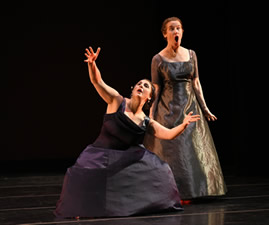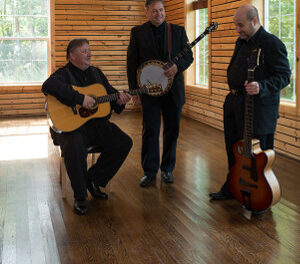This concert, “Kurt Weill on Broadway,” was part of the Kurt Weill Festival. (For more information about this festival within a festival, see the web sites of the Brevard Music Center, the Kurt Weill Foundation for Music, Classical Voice of North America, and previous CVNC reviews here and here.)
Pre-concert and post-concert lecture/discussions by Weill experts attending a concurrent symposium have given the Brevard audiences information about Weill’s fifteen years in Berlin theater followed by fifteen years on Broadway and in Hollywood. Kim H. Kowalke, President of the Kurt Weill Foundation for Music, and Joseph Horowitz, author of Artists in Exile, suggest that this concert might better have been named “Amerika America.” Neither Bertolt Brecht nor Weill had visited “Amerika” when in 1933 they wrote a major work (in German) set in eight locations in their imagined country. The second America is the very real country that Weill embraced enthusiastically after 1935.
Weill’s last work with a libretto in German was Die sieben Todsünden (The Seven Deadly Sins). The front half of Whittington-Pfohl Auditorium was curtained off into a more intimate hall (about 900 seats) whose stage held a projection screen, a small theatrical orchestra, and the vocalists. Conductor Keith Lockhart cued the orchestra, conducted a few measures, and then turned to the hall to begin singing Weill’s most familiar work, “Mack the Knife” from The Threepenny Opera. Lockhart sang it in the original German: “Moritat” aus Die Dreigroschenoper. One by one, a student baritone (Franklin Mosely), a tenor (Taylor Rawley), a bass-baritone (Timothy Madden) and another tenor (Victor Cardamone) came on stage and continued the song. Lockhart then gave a spoken introduction to Weill’s life and began The Seven Deadly Sins. Throughout this well-staged evening, images on the screen underscored the music.
Die sieben Todsünden was commissioned by George Balanchine; it featured a score by Weill, a libretto by Brecht, and choreography by Balanchine. Brecht and Weill wrote the work in Paris before moving to the United States for their exile from Nazi Germany. Originally, a ballet was performed in parallel with the live music.
The plot involves Anna I (a soprano singing role) and Anna II (a silent dancer), who are one person. The male quartet play Anna’s family, with the mother a bass-baritone! The family sends the two Annas on a seven-year trip to earn money to build a house; each year brings Anna to a different city and a different sin in the pursuit of money. The movement titles translate as Prologue, Sloth, Pride, Anger, Gluttony, Lust, Avarice, Envy, and Epilogue. The text is profoundly anti-capitalist and includes the family imploring their Anna to remember the importance of the “Way to Prosperity,” which apparently requires indulging in all seven sins. The text also indicates that “laws make us rich and happy.”
This production used Weill’s original orchestral scoring, with 17 strings plus winds and percussion. There was no ballerina to be Anna II, but modern technology (projected images) provided visual interest. Weimar art by Otto Dix, Rudolph Scheichter, and Caspar Neher was displayed, appropriate to each movement. (Neher had designed the sets for Die Dreigroschenoper in its original Berlin production.) The visiting soprano, the Broadway star Lisa Vroman (Anna I), provided additional on-stage drama, arriving with a suitcase, removing items to illustrate the various movements, going about the stage, and talking to a dressmaker’s form in an evening gown that represented Anna II. With her brassy red hair in a pixie cut and her strong chin, Vroman was convincing in the part of Anna I, giving pragmatic advice to ignore morality and seek profit. The entire production was exemplary.
Following intermission, a 1940s wartime recorded interview with Weill allowed us to hear him expressing his pride in being an American. From the moment he landed in New York, he refused to speak German; and took out US citizenship in 1943. Between 1935 and his untimely death in 1950, he composed eight Broadway musicals and, as Lockhart pointed out, never repeated a pattern.
Two female student vocalists – Chelsea Helm, soprano, and Esther Atkinson, mezzo-soprano – joined the four male students. Fourteen songs from those Broadway shows were presented, mostly in chronological order. We heard songs from Knickerbocker Holiday (lyrics by Maxwell Anderson) and Lady in the Dark (lyrics by Ira Gershwin), including Vroman arriving on stage for “One Life to Live.” We also heard works from One Touch of Venus (lyrics by Ogden Nash), Street Scene (lyrics by Langston Hughes), Love Life (lyrics by Alan Jay Lerner), and Lost in the Stars (lyrics by Maxwell Anderson). Then, out of chronological order, Vroman sang a show-stopping “Jenny” from Lady in the Dark, and the complete cast sang the final number of the evening, “Life, Love and Laughter” from Firebrand of Florence (lyrics by Ira Gershwin). The student vocalists were all good, but the male singers had an edge. Perhaps because the four had rehearsed hours together for Seven Deadly Sins, they had a tight collaboration that the female students lacked.
Weill’s American style was different from his German theatrical style. In Berlin, his music was full of irony, sardonic humor, and angularity. In America, he saw hope, gentle humor, and smoothness. Weill was an amazing theatrical composer in both languages, and in both halves of his career he wrote music with social purpose. He left a mark on the musical theater, perhaps most indelibly in his Broadway opera, Street Scene, adapted by Elmer Rice from Rice’s Pulitzer Prize-winning play and with lyrics by Hughes, the leading poet of the Harlem Renaissance. That opera will be staged in Brevard on July 27 and July 29, a production of the Janiec Opera Company of the Brevard Music Center. The Weill Festival will end with that. See our calendar for details.












